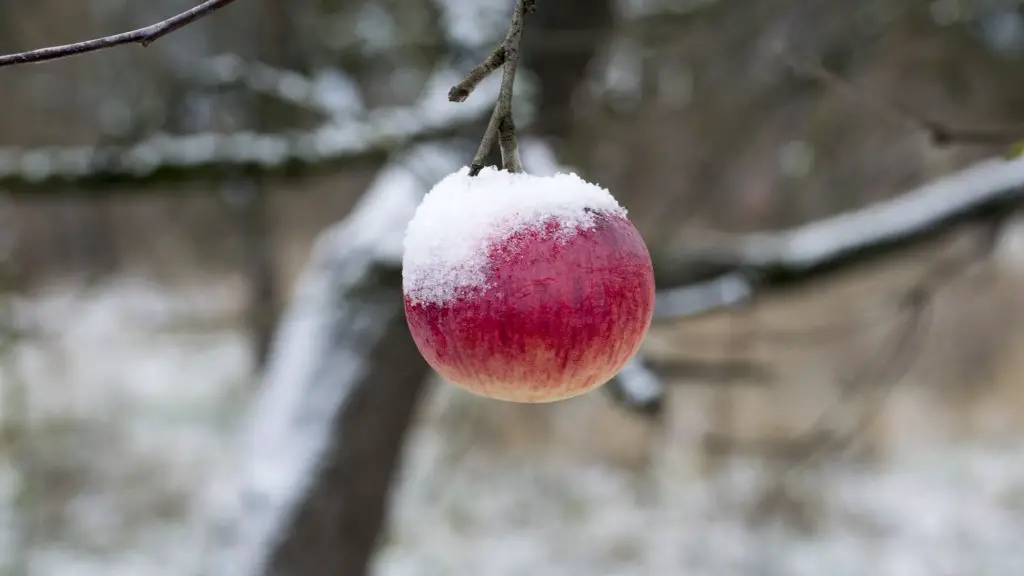Apple trees take a few years before they become mature enough to produce fruit. On average it takes between four to six years from the time of planting for an apple tree to become mature enough to produce fruit. Most of the trees start bearing fruit after about five years, but some can take as long as seven years or more. It all depends on the type and variety of the tree and the kind of conditions it is growing in.
Soil fertility and temperature are important factors when it comes to fruit production of apple trees. The soil must be well nourished for the trees to grow and it must receive enough sunlight to promote sustainable growth. Good cultivation practices like timely fertilization, irrigation and proper pruning can also help to ensure that apple trees reach maturity faster.
In colder climates, it might take longer for an apple tree to produce fruit because the trees need extra winter protection and they may take a while to break dormancy each spring. As there is less and shorter hours of daylight in colder climates, the apple trees may ripen later than those in warmer climates.
The variety of the tree also matters. Some apple varieties are known for their early fruiting period and these tend to produce fruit faster than other varieties. For example, certain varieties like Jonathan, Red Delicious and Granny Smith take five to seven years to start producing fruit, while other varieties like Honeycrisp and Braeburn start producing fruit within three to five years from the time of planting.
After an apple tree matures it will begin to produce fruit annually, provided that good cultivation practices are followed. Environmental conditions can also affect the amount of fruit the tree yields each year. For example, too little or too much rain can cause a decrease in the amount of fruit produced.
Factors That Can Affect Apple Tree Maturity
In order for a tree to become mature enough to produce fruit, certain environmental and cultivation factors must be taken into account. The soil should be well fertilized and irrigated at regular intervals. This will ensure that the tree receives all the necessary nutrients it needs for growth. Also, make sure to prune the tree each spring so that it can grow into the desired shape and form.
In colder climates, extra winter protection may be needed to protect the tree from frostbite and other extreme cold weather conditions. This can help the tree survive and reach maturity faster. In addition, proper amounts of nutrients and sunlight are essential for quick fruit production.
Fruit tree spacing is also very important. The trees should be properly spaced apart so that they can receive an adequate amount of sunlight and air circulation. This will help them grow strong and get fruit at a faster rate.
Finally, disease prevention is extremely important in order to ensure good fruit production. Make sure to routinely check the trees for any signs of disease and treat them accordingly, if necessary.
Pruning Apple Trees for Fruit Production
Pruning plays an important role in ensuring that apple trees reach maturity quickly and produce plenty of fruits. Pruning helps develop a strong structure and encourages the trees to focus energy on fruit production.
When pruning apple trees, the main goal is to create an open center. This means reducing the number of branches and twigs concentrated in the crown and creating a gap in the center. This allows for better air circulation and sunlight to penetrate through.
The ideal time for pruning apple trees is in early spring, just before bud break. At this time, it is important to remove diseased, dead, and cracked branches and twigs. This will create a strong framework which will encourage the tree to focus its energy on growth and fruit production.
Pruning also helps to promote healthy fruit development and prevents overcrowding. When pruning, be sure to cut back branches that have been recently damaged or weakened. This will help the tree transfer energy to new shoot and bud growth.
In addition, it’s important to prune properly so as to avoid damage and diseases. Pruning is an important part of apple tree maintenance and can help ensure quick and healthy fruit production.
Apple Tree Fertilization
Fertilization is another important technique to promote healthy and fast fruit production. Applying adequate amounts of fertilizer to your apple tree can help promote growth and yield more fruit.
The key is to choose a fertilizer which is tailored to the needs of your specific tree. This will help you provide the necessary nutrients for optimal growth and fruit production. A fertilizer should be applied once or twice a year, depending on the type of tree and the type of fertilizer.
Organic fertilizers, such as compost and manure, are a great choice for apple trees. They are rich in nutrients which help to nourish the soil and promote vigorous growth. Compost and manure also help to retain moisture in the soil, which can help to prevent drought-like conditions and promote healthy fruit production.
In addition to organic fertilizers, there are also chemical fertilizers which may be necessary in certain situations. Chemical fertilizers can provide essential nutrients which are not found in organic fertilizers, however they should be used sparingly and in moderation.
It is important to get the right type and amount of fertilizer for your apple tree in order to ensure quick fruit production. Applying fertilizer at the right intervals can help to promote healthy growth and prolific fruit production.
Irrigation and Watering of Apple Trees
Regular watering is essential for apple tree growth and fruit production. In order for a tree to mature and produce fruit quickly, it needs an adequate amount of water. During periods of prolonged dry spells, be sure to water the tree at least once a week.
The best way to water is by using a drip irrigation system or soaker hose. This helps to ensure that the water is evenly distributed throughout the tree and is not wasted. Make sure to water in the morning so that the tree has plenty of time to absorb the water before nightfall.
It is also important to monitor the frequency of watering and make sure that your apple tree is not over-watered or under-watered. Over-watering can cause root rot, while under-watering can cause poor growth and a decrease in fruit production. Strike a balance between these two and water correctly.
Also, mulching your apple tree is a great way to help retain moisture in the soil. Mulch can also help to suppress weed growth and discourage pests and diseases. This will ensure that your tree will remain healthy and continue to produce fruit in abundance.
Dealing With Pests and Diseases
In order to ensure healthy fruit production, it’s important to check your apple tree for signs of pests and diseases. Pests and diseases can have a drastic effect on the tree’s growth and can even lead to a decrease in fruit production.
The key is to act quickly and take preventive measures. A great way to discourage pests and prevent diseases is by providing a protective barrier around the tree. This can be done by using an insecticidal spray or applying a horticultural oil.
In addition, it’s important to check your tree regularly for any signs of infection. Be sure to look for any wilting, discoloration, and unusual bumps and discolorations on the leaves and fruits. If you do notice any of these signs, it’s important to take appropriate action quickly in order to prevent any further spread.
Having a good pest and disease management plan in place is key to promoting healthy fruit production. Taking the necessary steps to protect your tree from pests and diseases will ensure that it always remains healthy and will continue producing fruit in abundance.
Conclusion
Apple trees can take between four to six years to reach maturity and produce fruit, depending on the type and variety of the tree and the environmental conditions. Good cultivation practices like timely pruning, fertilization, irrigation and pest and disease management are essential for healthy fruit production. By following the steps outlined above, you can ensure that your apple tree will reach maturity quickly and produce fruit in abundance.





